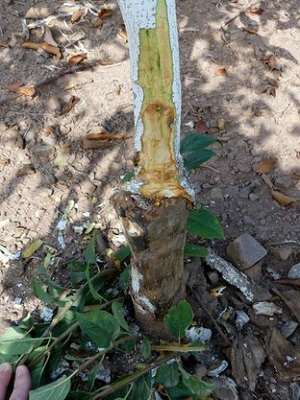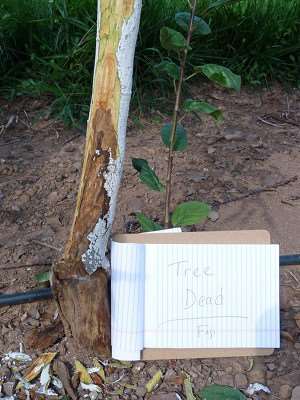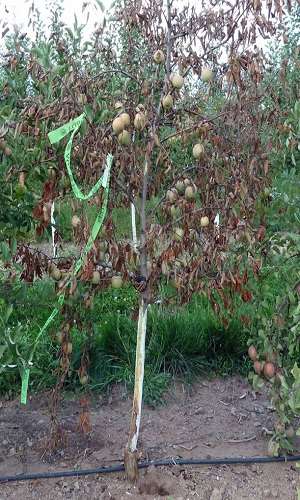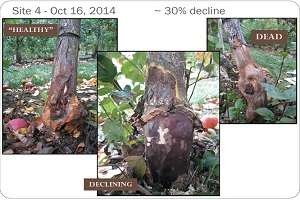The mystery surrounding rapid apple decline/sudden apple decline of young, dwarf apple trees. For the last several years, there have been many reports in Pennsylvania and, most recently, in the Northeast and states south about unusual sudden decline of young, dwarf apple trees.

The issue has been labeled ‘Rapid Apple Decline’ (RAD) or ‘Sudden Apple Decline’ (SAD) based on how fast the trees die from the first symptoms to total collapse of the tree. The common denominator in all situations seems to revolve around the graft union. Although the problem has not been solved, this article summarizes what we know to date and the questions we are pursuing.
When talking about the story of ‘Rapid Apple Decline,’ I need to start at the very beginning – as in when my time at Penn State commenced in 2013. During my first season in 2013, I was faced with an unusual problem in a three acre plant pathology research apple block that was planted in 2011. This apple block, which was comprised of multiple varieties on M9, was to replace a much older semi-dwarf plant pathology block; however, hopes were dashed in 2013 when a massive die-off of trees in the new block occurred.
Many chemicals were used (Aliette, Rampart, Ridomil) to try to save this apple block, but none of our remedies worked. In 2014, the problem continued and we discovered Penn State wasn’t the only one in Pennsylvania with a problem orchard afflicted with a mysterious issue causing sudden collapse of trees. The usual culprits (tomato ringspot virus, Phytophthora, fire blight infection) that may cause collapse of trees didn’t quite fit the symptoms we were observing in the declining trees.
Consequently, we needed some extra assistance, so we decided to enlist the help of the plant pathology team at the Pennsylvania Department of Agriculture (PDA).
Since 2014, my lab has been working closely with PDA on this issue and we have been able to at least rule out a few things, but have also generated more questions. Most recently, Penn State has joined forces with Cornell, North Carolina State University, VA Tech, University of Massachusetts, Canada, and everyone else in between who work with tree fruit growers in the Northeast and points south to try begin to flush out an understanding since RAD is not exclusive to Pennsylvania. In addition, we’ve reached out to labs at the USDA-ARS in Beltsville, MD. In other words: we’re on it.
Unfortunately, we are scratching our heads raw trying to figure out the issue with no clear answer in sight. In the meantime, I’ve compiled a good list of FAQ when it comes to RAD for growers who are struggling with this problem.
What is ‘Rapid Apple Decline’ or ‘Sudden Apple Decline’?
RAD was named by PDA due to the rapid or sudden collapse of apple trees from the time the first symptoms appear to tree death. The diagnostic characteristics are as follows:
- A block can have a mix of dead, declining and healthy trees dispersed fairly evenly throughout a block.
- Young (2 – 8 yr), dwarf trees are most susceptible (to date, semi-dwarf rootstocks have not been associated with this issue); multiple varieties and rootstocks (M9 most affected).
- The graft union is affected: severe shedding of bark around graft union and cankers are present.
- Necrosis begins at the graft union and it proceeds up the trunk of the tree.
- Affected wood is usually solid and not spongy.
- The rootstock is healthy, as indicated by many rootstock suckers present, as well as a healthy root system.
- The leaves on the trees begin to look pale yellow, then reddish (indicating tree girdling), and within two weeks the tree can be dead.
- Trees can collapse with a full load of large fruit.
- Total collapse of the trees has been observed from late July through September.
What tree varieties are affected by RAD/SAD and where has this been observed?
In Pennsylvania, we have observed the issue on young trees with dwarfing rootstocks; M.9 (including 337 and Nic29) appears especially susceptible, as well as the cultivars Fuji, Gala, and Golden Delicious. RAD has been described in PA, Ontario, New York, and North Carolina; however, there is a very good possibility this issue is not limited to these regions. The issue may be a cultivar – rootstock combination; however, this question needs further study. Another item to note is these trees came from multiple sources.
Is RAD/SAD due to the harsh winters of 2014 and 2015, or drought?
If you talk to many folks, winter injury is the ultimate cause for RAD: the trees became weakened due to the stress (severe temperature fluctuations) of winter and ultimately became susceptible to weaker diseases that caused the tree to decline and die. This is a very plausible hypothesis since our 2014 and 2015 winters were exceptionally challenging. However, I question this theory based on my own observations in my problematic apple block.
My problem apple block has 4 different varieties and the only ones affected are Fuji, Gala, and Golden Delicious (the variety rows). The buffer rows, which are Crimson Crisp, have not been affected. The variety and buffer rows are arranged as every other row, so distributed evenly throughout the 3 acres. If it were due to winter conditions, I would have suspected to see Crimson Crisp die off just as much as the other varieties. Also, we started to see the problem prior to 2014. Prior to 2014, we did experience drought issues and my problem child block had not had the irrigation installed yet, so the stress due to drought conditions may have contributed to RAD—but again, the Crimson Crisp were not affected. Those in New York suspect the drought conditions this year may have been the tipping point that pushed the trees over the edge with regard to tree stress and susceptibility.

Is RAD/SAD due to fire blight?
This has been a prevailing hypothesis that many want to anchor onto; however, in our collaborations with PDA and discussions with Cornell, the bacteria has not been detected in affected trees. We are tentatively ruling out fire blight as a cause of RAD; however, we are pursuing more sensitive testing to officially rule it out.
Is RAD/SAD due to Phytophthora infection?
Although the symptoms of the graft union are suspect of a Phytophthora infection, we have ruled out Phytophthora in PA since we have not been able to isolate Phytophthora from the samples we have collected to date. In addition, the affected sites have had excellent drainage.
Is RAD/SAD due to virus infection?
Tomato ringspot virus, which is the most problematic virus to affect our region since it is vectored by dagger nematodes, has been ruled out more than once. The apple trees tested negative, as well as the weeds (horse nettle) in the orchard. As far as other viruses…in Pennsylvania, we have been detecting latent viruses (apple stem pitting virus and apple stem grooving virus) that are graft transmissible only; however, not all samples possessed a latent virus, so we cannot call this the smoking gun. The issue of a virus infection is still being aggressively pursued as we are collaborating with a plant virus lab at the USDA-ARS in Beltsville, MD.

Is RAD/SAD due to insects?
We (and others) have observed borer issues in the graft union; however, this wasn’t a common denominator among affected trees. We suspect these insects came in after the fact when the tree was already in decline.
Is RAD/SAD due to nematodes?
Nematodes were found in some locations, but not others. When nematodes were identified in soil samples, the numbers and types of nematodes detected would not cause significant damage. To further support this hypothesis, the root systems of all affected trees we have encountered to date are incredibly healthy, so much so they are producing rootstock suckers.
Is RAD/SAD due to some other site issue?
This is another theory that has been floating around; however, I don’t believe it is site related. I use my Penn State apple block as an example where we have multiple varieties and only certain varieties are affected. If it were a site issue, I would see problems regardless of variety.
Well, what DO we know about RAD/SAD??
This is most likely a complex of issues and not just one abiotic or biotic issue causing it. Some kind of tree stress is most likely making trees susceptible, but we haven’t quite nailed down what the exact tree stress is. It may be multiple stressors. Other thoughts floating around are the long-term sub-lethal effects of certain herbicides, but more research is still needed.
What can a grower do to attempt to prevent RAD/SAD?
This is the million dollar question. Not knowing what the root cause that sends a tree down the RAD/SAD path, it is very difficult to give a good answer. Right now, the best action growers can do is to minimize tree stress. Although we do not ultimately know why trees are prone to stress to begin with, there are a few things growers can do to mitigate RAD/SAD since it seems to be most prone with trees that could have been stressed due to drought or severe winter conditions. If you already do not irrigate, consider irrigation for your apple block, especially if you have trees on M9 rootstocks. To limit winter injury, consider painting the trunks white or using white tree guards to prevent southwest injury.

Final thoughts
This is a very tough, serious, costly issue and it most likely will take some time to get to the bottom of the problem. A lot of minds in the industry are working together to figure this out. If what has been described resonates with you, these are the best words of wisdom I can share at the moment: You aren’t alone. The more we learn about RAD/SAD, we will be certain to pass it along.
Source: psu.edu